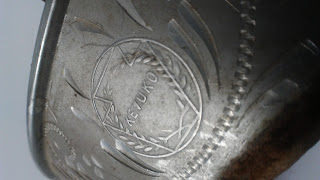 |
| My stereoscope, seen here from the top angle, with the handle on the bottom folded up to lie flat |
The major difference I've found between my stereoscope and others online is the metal center-piece. Many seem to have a wooden piece (seen in the image below) that stretches straight out so that the image can be adjusted to the correct depth for the viewer.
 |
| An image of someone else's stereoscope I found online. Photo source: http://antiquephotographics.com/stereoscopes-and-stereoviewers/ |
And from the "bottoms-up" view of my stereoscope (below), you can see that the straight-extension on my inherited Stereopticon is made from some sort of metal (it's light, so I'm going to guess aluminum) and that the painted wooden handle is intact.
 |
| View of my stereoscope from underneath, handle folded out |
While the slider piece and the part that bridges forward from the nose are both wooden (as is the handle, though painted white), I would guess that this makes my stereoscope more resistant to wear-and-tear.
Another thing I noticed as I looked through pictures and compared them to my stereoscope was the common discoloration around the part of the viewer that rests on the face. I'm guessing they must have used some type of oxidizing metal there while the rest of the scope was constructed of something a bit more rust-resistant. Mine certainly hasn't been cleaned or treated with anything otherwise, so that's my best guess. Another theory is that there was possibly some type of cloth or fur lining that was attached there and has since fallen away.
 |
| Under-side |
 |
| Hard to see, but it says: "KEVUKO" which may or may not be some relation to Keystone Viewing Company? |
 |
| A closer shot |
On the underside of the long extension arm is a stamp that says "PAT APR 5th 1904" and then below that (a bit tougher to read) is "PAT FEB 14th 1905."
So, that's the viewer I've inherited. The posts that follow will explore the photo cards that I've inherited along with it. There are quite a number of them, so I'm looking forward to digging in to find out what's there.
